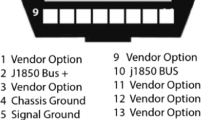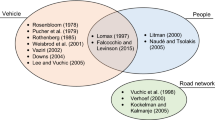Abstract
Various methods have been developed to predict automobile travel time, but they are often unreliable, especially when the travel time varies significantly during the transition between free flow and congested flow. This paper proposes a real-time travel-time prediction method. We apply a macroscopic traffic flow model with predicted boundary conditions and modify the scheme to calculate the traffic states to reflect the latest traffic conditions on a real-time basis. Our method uses traffic data from multiple observation systems, which is a crucial component for real-time application of the macroscopic traffic flow model that has not been previously applied to traffic flow models. The analysis of real traffic data collected from a section of the Korean Kyungbu Expressway shows that the proposed method outperforms other prediction methods, particularly during the transition between free flow and congested flow.
Similar content being viewed by others
References
Chen, M. and Chien, S. I. J. (2000). “Determining the number of probe vehicles for freeway travel time estimation by microscopic simulation.” Transportation Research Record: Journal of the Transportation Research Board, No. 1719, pp. 61–68, DOI: 10.3141/1719-08.
Choi, K. (1999). “Data fusion methodology for link travel time estimation for advanced traveler information system.” KSCE Journal of Civil Engineering, Vol. 3, Issue 1, pp. 1–14, DOI: 10.1007/BF02830731.
Coifman, B. (2002). “Estimating travel times and vehicle trajectories on freeways using dual loop detectors.” Transportation Research Part A: Policy and Practice, Vol. 36, Issue 4, pp. 351–364, DOI: 10.1016/S0965-8564(01)00007-6.
Du, L., Peeta, S., and Kim, Y. H. (2012). “An adaptive information fusion model to predict the short-term link travel time distribution in dynamic traffic networks.” Transportation Research Part B: Methodological, Vol. 46, Issue 1, pp. 235–252, DOI: 10.1016/j.trb.2011.09.008.
El Esawey, M. and Sayed, T. A. (2009). “Travel time estimation in an urban network using sparse probe vehicle data and historical travel time relationships.” Transportation Research Board 88th Annual Meeting, Washington D.C.
Faouzi, N-E. E., Leung, H., and Kurian, A. (2011). “Data fusion in intelligent transportation systems: Progress and challenges -A survey.” Information Fusion, Vol. 12, Issue 1, pp. 4–10, DOI: 10.1016/j.inffus.2010.06.001.
Lim, S. and Lee, C. (2011). “Data fusion algorithm improves travel time predictions.” IET Intell. Transp. Syst., Vol. 5, Issue 4, 2011, pp. 302–309, DOI: 10.1049/iet-its.2011.0014.
Oh, C. and Park, S. (2011). “Investigating the effects of daily travel time patterns on short-term prediction.” KSCE Journal of Civil Engineering, Vol. 15, Issue 7, DOI: 10.1007/s12205-011-1123-y.
Papageorgiou, M., Blosseville, J. M., and Hadj-Salem, H. (1990). “Modelling and real-time control of traffic flow on the southern part of boulevard Périphérique in Paris: Part I: Modelling.” Transportation Research Part A: General, Vol. 24, Issue 5, pp. 345–359, DOI: 10.1016/0191-2607(90)90047-A.
Payne, H. J. (1971). Models of freeway traffic and control, Simulation councils, Inc., pp. 51–61.
Tam, M. L. and Lam, W. H. K. (2009). “Short-term travel time prediction for congested urban road Networks.” Transportation Research Board 88th Annual Meeting, Washington D.C.
Van Lint, J. W. C. (2004). Reliable travel time prediction for freeways, Trail Thesis Series, No. T2004/3, The Netherlands TRAIL Research School, Delft, Netherland.
Van Lint, J. W. C., Hoogendoorn, S. P., and Van Zuylen, H. J. (2005). “Accurate freeway travel time prediction with state-space neural networks under missing data.” Transportation Research Part C: Emerging Technologies, Vol. 13, Issues 5-6, pp. 347–369, DOI: 10.1016/j.trc.2005.03.001.
Author information
Authors and Affiliations
Corresponding author
Rights and permissions
About this article
Cite this article
Lim, S.H., Kim, Y. & Lee, C. Real-time travel-time prediction method applying multiple traffic observations. KSCE J Civ Eng 20, 2920–2927 (2016). https://doi.org/10.1007/s12205-016-0239-5
Received:
Accepted:
Published:
Issue Date:
DOI: https://doi.org/10.1007/s12205-016-0239-5




